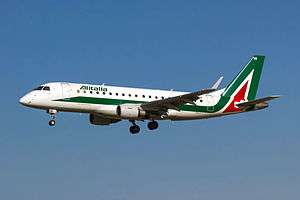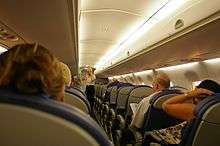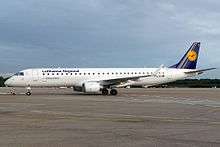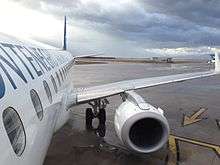Embraer E-Jet family
| E-Jet family E170 / E175 / E190 / E195 | |
|---|---|
 | |
| Embraer E175 of Alitalia CityLiner at Barcelona (2015) | |
| Role | Narrow-body jet airliner |
| National origin | Brazil |
| Manufacturer | Embraer |
| First flight | February 19, 2002 |
| Introduction | March 17, 2004 with LOT Polish Airlines |
| Status | In service |
| Primary users | Republic Airlines Azul Brazilian Airlines JetBlue Airways Compass Airlines |
| Produced | 2001–present |
| Number built | 1276 As of 30 September 2016[1] |
| Unit cost | |
| Variants | Embraer Lineage 1000 |
| Developed into | Embraer E-Jet E2 family |
The Embraer E-Jet family is a series of narrow-body medium-range twin-engine jet airliners produced by Brazilian aerospace conglomerate Embraer. Launched at the Paris Air Show in 1999, and entering production in 2002, the aircraft series has been a commercial success primarily for safety and efficiency offered by them.[4] The aircraft is used by mainline and regional airlines around the world. As of 30 September 2015, there is a backlog of 263 firm orders for the E-Jets, 433 options and 1158 units delivered.[5]
Design and development

The Embraer E-Jets line is composed of two main commercial families and a business jet variant. The smaller E170 and E175 make up the base model aircraft. The E190 and E195 are stretched versions, with different engines and larger wing, horizontal stabilizer and landing gear structures. The 170 and 175 share 95% commonality, as do the 190 and 195. The two families share near 89% commonality, with identical fuselage cross-sections and avionics, featuring the Honeywell Primus Epic Electronic flight instrument system (EFIS) suite.[6] The E-jets also have winglets to improve efficiency.
All E-Jets use four-abreast seating (2+2) and have a "double-bubble" design, which Embraer developed for its commercial passenger jets, that provides stand-up headroom. The E190/195 series of aircraft have capacities similar to the initial versions of the McDonnell Douglas DC-9 and Boeing 737, which have always been considered mainline airliners.[7] The E-Jets have turbofan engines designed to reduce noise, which allows them to operate in airports that have strict noise restrictions, such as London City Airport.[8]

Embraer first disclosed that it was studying a new 70-seat aircraft, which it called the EMB 170, in 1997, concurrently with announcing the development of its ERJ 135.[9] The EMB 170 was to feature a new wing and larger-diameter fuselage mated to the nose and cockpit of the ERJ 145.[10][11] In February 1999, Embraer announced it had abandoned the derivative approach in favour of an all-new design.[12][13]
The E-jet family was formally launched at the Paris Air Show on 14th June 1999[14] as ERJ-170 and ERJ-190, designations later changed to EMBRAER 170 and EMBRAER 190. Launch customers for the aircraft were the French airline Régional Compagnie Aérienne Européenne with ten orders and five options for the E170;[7] and the Swiss airline Crossair with an order for 30 E170s and 30 E190s.[15] Production of parts to build the prototype and test airframes began in July 2000.[16] The first prototype (PP-XJE)[17] rolled out on October 29th, 2001 [18] at São José dos Campos, Brazil. Its first flight occurred on February 19th, 2002, marking the beginning of a multi-year flight test campaign. Full production began in 2002, at a new factory built by Embraer at its São José dos Campos base.[19] After several delays in the certification process, the E170 received type certification from the aviation authorities of Brazil, Europe and the United States in February 2004.[20][21]
E-Jets Second Generation
In November 2011, Embraer announced that it would develop revamped versions of the E-Jets family with improved engines, rather than an all-new aircraft.[22] The new variants are to be powered by new more efficient engines with larger diameter fans, and include slightly taller landing gear, and possibly a new aluminum or carbon fiber-based wing. The new E-Jet variants are to be better-positioned to compete with the Bombardier CSeries. The new variants are to enter service in 2018.[23]
GE, Pratt & Whitney, and Rolls-Royce were possible engine suppliers for Embraer E-Jet family. However, there is Aviadvigatel as a possible Russian option .[24] Pratt & Whitney's geared turbofan engine was selected in January 2013 for the new E-Jets versions.[25][26] The Honeywell Primus Epic 2 was selected as the avionics package.[27]
In February 2012, Embraer announced it was studying the development of a new variant with 130 seating capacity.[28] The study was expected to be completed by the end of 2012.[29]
Operational history

The first E170s were delivered in the second week of March 2004 to LOT Polish Airlines, followed by US Airways subsidiary MidAtlantic Airways and Alitalia[21][30] (launch customer Crossair had in the meantime ceased to exist after its takeover of Swissair; and fellow launch customer Régional Compagnie Aérienne deferred its order,[31] not receiving its first E-jet—an E190LR—until 2006.[32]) LOT operated the first commercial flight of an E-jet on 17 March 2004, from Warsaw to Vienna.[33] The largest single order for any type of E-Jets has come from JetBlue, which ordered 100 Embraer 190s in 2003 and took its first delivery in 2005.[6]
The 400th E-jet was delivered in 2008, to Republic Airlines in the U.S.[34] On 6 November of that year, JetBlue set the record for the longest flight of the E-190 family when one of its aircraft made a non-stop flight from Anchorage, Alaska (Ted Stevens Anchorage International Airport) to Buffalo, New York (Buffalo Niagara International Airport), a total of 2,694 nmi (4,989 km). This was an empty aircraft on a non-revenue flight. The aircraft eventually returned to JFK after a two-month-long charter service with Vice Presidential candidate Sarah Palin.[35] In September 2009, the 600th E-jet built was delivered to LOT Polish Airlines.[36] Kenya Airways received its 12th Ejet from Embraer which was also the 900th Ejet ever produced on October 10, 2012.[37]
On 13 September 2013, a ceremony was held at the Embraer factory in São José dos Campos to mark the delivery of the 1,000th E-jet family aircraft, an E175, to Republic Airlines. The E175 was delivered in an American Eagle colour scheme with a special "1,000th E-Jet" decal above the cabin windows.[34][38]
Variants
.jpg)


E170 and E175
The E170/E175 models[7] in the 80-seat range are the smaller in the EJet family. They are powered with General Electric CF34-8E engines of 14,200 pounds (62.28 kN) thrust each. The E170 and E175 directly compete with the Bombardier CRJ-700 and Bombardier CRJ-900, respectively, and loosely compete with the turboprop Bombardier Q400. They also seek to replace the market segment occupied by earlier competing designs such as the BAe 146 and Fokker 70.
The Embraer 170 was the first version produced. The prototype 170-001, registration PP-XJE, was rolled out on 29 October 2001, with first flight 119 days later on 19 February 2002. The aircraft was displayed to the public in May 2002 at the Regional Airline Association convention. After a positive response from the airline community, Embraer launched the E175. First flight of the stretched E175 was on June 2003.[20] The launch U.S. customer for the E170[7] was US Airways, after FAA certification, the aircraft entered into revenue service on April 4, 2004 operated by the MidAtlantic division of US Airways, Inc. The first E175 was delivered to Air Canada and entered service in July 2005.[20] The 170-001 prototype performed its last flight on April 11, 2012. Its destiny was disassembly in the US for spare parts.
E190 and E195
The E190/195 models are a larger stretch of the E170/175 models fitted with a new, larger wing, a larger horizontal stabilizer and a new engine, the GE CF34-10E, rated at 18,500 lb (82.30 kN). These aircraft compete with the Bombardier CRJ-1000 and CS100, the Boeing 717-200 and 737-600, and the Airbus A318. It can carry up to 100 passengers in a two-class configuration or up to 124 in single-class high density configuration.[39]
The first flight of the E190 was on March 12, 2004 (PP-XMA),[40] with the first flight of the E195 (PP-XMJ)[40] on December 7 of the same year. The launch customer of the E190 was New York-based low-cost carrier JetBlue with 100 orders options in 2003 and took its first delivery in 2005.[6] British low-cost carrier Flybe was the first operator of the E195, had 14 orders and 12 options, and started E195 operations on 22 September 2006.[41]
Air Canada operates 45 E190 aircraft fitted with 9 business-class and 88 economy-class seats as part of its primary fleet. JetBlue and American Airlines also operate the E190 as part of their own fleet thus allowing airlines increased crewing flexibility by having the ability of cabin crews to work aboard narrow-body or widebody aircraft.
Embraer Lineage 1000

On 2 May 2006, Embraer announced plans for the business jet variant of the E190,[7] type name ERJ190-100 ECJ. It has the same structure as the E190, but with an extended range of up to 4,200 nmi, and luxury seating for up to 19. It was certified by the USA Federal Aviation Administration on 7 January 2009. The first two production aircraft were delivered in December 2008.
Undeveloped variants
E195X
Embraer considered producing an aircraft which was known as the E195X, a stretched version of the E195. It would have seated approximately 130 passengers. The E195X was apparently a response to an American Airlines request for an aircraft to replace its McDonnell Douglas MD-80s.[42] Embraer abandoned plans for the 195X in May 2010, following concerns that its range would be too short.[43]
Operators
_lands_at_Bristol_Airport%2C_England_15Aug2016_arp.jpg)

As of December 2015, the Embraer fleet consists of the following aircraft:[44]


- Embraer 170 (E170 or EMB 170-100)—As of July 2015, 180 Embraer 170 aircraft (all variants) are in airline service, with 5 orders. Major operators include: Shuttle America (50), Republic Airlines (22), HOP! (16), Saudia (15), J-Air (15), EgyptAir Express (12), Aeromexico Connect (8), LOT Polish Airlines (7), Compass Airlines (North America) (6) and BA CityFlyer (6). Nine other airlines operate the type in smaller numbers.[45]
- Embraer 175 (E175 or EMB 170-200)—As of July 2015, 285 Embraer 175 aircraft are in airline service, with 165 further orders. Major operators include Republic Airlines (85), Compass Airlines (North America) (56), Mesa Airlines (48), SkyWest Airlines (58), Shuttle America (16), Sky Regional Airlines (15), Alitalia CityLiner (15), LOT Polish Airlines (12) and Flybe (11). Major firm orders include 55 aircraft for Shuttle America, 40 aircraft for Envoy Air, and 33 for Horizon Air.
- Embraer 190 (E190 or EMB 190-100)—As of July 2015, 506 Embraer 190 aircraft (all variants) are in airline service, with 47 orders. Major operators include JetBlue Airways (60), Air Canada (45), Tianjin Airlines (45), Aeromexico Connect (30), KLM Cityhopper (30), Austral Lineas Aereas (26), Azul Brazilian Airlines (22), China Southern Airlines (20), TAP Express (10), American Airlines (19), Virgin Australia (18), Conviasa (15), Bulgaria air (4) and other operators with fewer aircraft.[45]
- Embraer 195 (E195 or EMB 190-200)—As of July 2015, 134 Embraer 195 aircraft (all variants) are in airline service, with 25 firm orders. Major operators are Azul Brazilian Airlines (66), Lufthansa CityLine (24), Air Europa (11), Borajet (10), Air Dolomiti (10), Flybe (9), LOT Polish Airlines (6) and other operators with fewer aircraft. Azul Brazilian Airlines have ordered an additional 5 aircraft of this type.[45]
Orders and deliveries
List of Embraer's E-Jet family deliveries and orders:
| Model | Firm Orders | Options | Deliveries | Firm Order Backlog |
|---|---|---|---|---|
| E170 | 193 | 6 | 190 | 3 |
| E175 | 525 | 276 | 395 | 130 |
| E190 | 590 | 55 | 531 | 59 |
| E195 | 166 | 3 | 151 | 15 |
| Total | 1474 | 340 | 1267 | 207 |
Source: Embraer's order book on September 30, 2016.[46]
Accidents and incidents
- On 18 February 2007, Shuttle America Flight 6448 (an ERJ-170 operating for Delta Connection) ran off the runway on landing at Cleveland Hopkins International Airport, Ohio in poor visibility during a snowstorm. None of the 75 passengers and crew aboard were injured, and the aircraft, while significantly damaged, was repaired and returned to service.[47]
- On 17 July 2007, Aero República Flight 7330 overran the runway while landing at Simón Bolívar International Airport in Santa Marta, Colombia. The ERJ-190 slid down an embankment off the side of the runway and came to rest with the nose in shallow water. The aircraft was damaged beyond repair, but all 60 aboard evacuated unharmed.[48]
- On 24 August 2010, Henan Airlines Flight 8387, an E190 that departed from Harbin, People's Republic of China, crash landed about 1 km short of the runway at Yichun Lindu Airport, resulting in 44 deaths.[49]
- On 16 September 2011, an ERJ-190 operated by TAME landed long and ran off the end of the runway at Mariscal Sucre International Airport in Quito, colliding with approach equipment and a brick wall. The crew reportedly failed to adhere to the manufacturer's procedures in the event of a flap malfunction, continuing the approach in spite of the aircraft's condition. Eleven of the 103 aboard received minor injuries, and the aircraft was written off.[50]
- On 29 November 2013, LAM Mozambique Airlines Flight 470, an E190, crashed in Namibia, killing all 33 aboard (27 passengers, 6 crew members).[51] The co-pilot reportedly left the cockpit to use the toilet. He was then locked out by the captain, who dramatically reduced the aircraft’s altitude and ignored various automated warnings ahead of the high-speed impact.[52]
Specifications
_(2).jpg)
| Variant | E170 (ERJ170-100) |
E175 (ERJ170-200) |
E190 (ERJ190-100) |
E195 (ERJ190-200) |
|---|---|---|---|---|
| Flight deck crew | 2 pilots | |||
| Passenger capacity | 80 (1-class, 29 in/30 in pitch) 78 (1-class, 30 in/31 in) 70 (1-class, 32 in) 70 (2-class, 36 in/32 in) [53] |
88 (1-class, 30 in pitch) 86 (1-class, 31 in) 78 (1-class, 32 in) 78 (2-class, standard) [54] |
114 (1-class, 29 in/30 in pitch) 106 (1-class, 31 in) 98 (1-class, 32 in) 94 (2-class, standard) [55] |
122 (1-class, 30 in/31 in pitch) 118 (1-class, 31 in) 108 (1-class, 32 in) 106 (2-class, standard) [56] |
| Length | 29.90 m (98 ft 1 in) |
31.68 m (103 ft 11 in) | 36.24 m (118 ft 11 in) | 38.65 m (126 ft 10 in) |
| Wingspan | 26.00 m (85 ft 4 in) | 26.00 m (85 ft 4 in) / 28.70 m (94 ft 2 in) (Enhanced Wing Tip version) |
28.72 m (94 ft 3 in) | |
| Height | 9.67 m (32 ft 4 in) |
10.57[57] m (34 ft 7 in) | ||
| Empty Weight | 21,140 kg (46,610 lb) | 21,810 kg (48,080 lb) | 28,080 kg (61,910 lb) | 28,970 kg (63,870 lb) |
| Maximum takeoff weight | 35,990 kg (79,340 lb) (STD) 37,200 kg (82,000 lb) (LR) 38,600 kg (85,100 lb) (AR) |
37,500 kg (82,700 lb) (STD) 38,790 kg (85,520 lb) (LR) 40,370 kg (89,000 lb) (AR) |
47,790 kg (105,360 lb) (STD) 50,300 kg (110,900 lb) (LR) 51,800 kg (114,200 lb) (AR) |
48,790 kg (107,560 lb) (STD) 50,790 kg (111,970 lb) (LR) 52,290 kg (115,280 lb) (AR) |
| Max payload weight | 9,100 kg (20,100 lb) (STD&LR) 9,840 kg (21,690 lb) (AR) |
10,080 kg (22,220 lb) (STD&LR) 10,360 kg (22,840 lb) (AR) |
13,080 kg (28,840 lb) | 13,650 kg (30,090 lb) |
| Takeoff Run at MTOW | 1,644 m (5,394 ft) | 2,244 m (7,362 ft) | 2,056 m (6,745 ft) | 2,179 m (7,149 ft) |
| Powerplants | 2× GE CF34-8E turbofans 61.4 kN (13,800 lbf) thrust each 63.2 kN (14,200 lbf) APR thrust each |
2× GE CF34-10E turbofans 82.3 kN (18,500 lbf) thrust each 89 kN (20,000 lbf) APR thrust each | ||
| Maximum speed | 890 km/h (481 kn, Mach 0.82) | |||
| Range | STD: 3,334 km (1,800 nmi) LR: 3,889 km (2,100 nmi) AR: 3,982 km (2,150 nmi) |
STD: 3,241 km (1,750 nmi) LR: 3,982 km (2,150 nmi) AR: 4,074 km (2,200 nmi) |
STD: 3,426 km (1,850 nmi) LR: 4,445 km (2,400 nmi) AR: 4,537 km (2,450 nmi) |
STD: 2,963 km (1,600 nmi) LR: 3,704 km (2,000 nmi) AR: 4,260 km (2,300 nmi) |
| Maximum fuel load | 9,335 kg (20,580 lb) | 12,971 kg (28,596 lb) | ||
| Service ceiling | 12,500 m (41,000 ft) | |||
| Thrust-to-weight | 0.42:1 | 0.39:1 | 0.41:1 | 0.39:1 |
| Fuselage and cabin cross-section | ||||
| Outer width | 3.01 m (9 ft 11 in) | |||
| Cabin width | 2.74 m (9 ft 0 in) | |||
| Outer height | 3.35 m (11 ft 0 in) | |||
| Cabin height | 2.00 m (6 ft 7 in) | |||
Sources: Embraer Ejet[58]
See also
- Related development
- Aircraft of comparable role, configuration and era
- Airbus A318
- Antonov An-148
- Boeing 717
- Boeing 737-600
- Bombardier CRJ700 series
- Bombardier CSeries
- Comac ARJ21
- Fokker 70/100
- Mitsubishi MRJ 70/MRJ 90
- Sukhoi Superjet 100
- Tupolev Tu-334
- Related lists
References
- ↑ "Embraer's Commercial Aircraft Deliveries Up 38% in 3Q16" (PDF). embraer.com. line feed character in
|title=at position 52 (help) - ↑ Embraer CEO Sees U.S. Airlines Back for More Amid Orders Bloomberg business by Tim Catts, Robert Wall and Leslie Picker, June 18, 2013
- ↑ Reed Business Information Limited. "ANALYSIS: Lessors spurn CSeries overtures". flightglobal.com. Retrieved 25 January 2015.
- ↑ "Embraer: E-Jet sales success spurred deployment hiccups-22/05/2007-Washington DC-Flight International". Retrieved 2016-06-23.
- ↑ "Embraer In Numbers". Embraer.com. Retrieved 2012-10-16.
- 1 2 3 JetBlue CEO Laments Embraer 190 Costs AWIN First, Jens Flottau, Apr 22, 2013
- 1 2 3 4 5 "Aircraft ICAO and IATA codes: Embraer". www.airlineupdate.com. Retrieved 2015-12-29.
- ↑ List of permitted aircraft on LCY
- ↑ Walker, Karen; Lopez, Ramon (12–18 March 1997). "Embraer seeks Paris show launch for new 37-seat regional turbofan". Flight International. Reed Business Information. 151 (4565): 4.
- ↑ "Paris report '97: Continental Express is eager for small regional jet". Flight International. Reed Business Information. 151 (4579): 10. 25 June – 1 July 1997.
- ↑ Warwick, Graham (24–30 September 1997). "Embraer launches 37-seater". Flight International. Reed Business Information. 152 (4593): 7.
- ↑ Endres (2001), p.288
- ↑ Lewis (2001), p.34
- ↑ http://www.centrohistoricoembraer.com.br/pt-BR/HistoriaAeronaves/Paginas/EMBRAER-170.aspx
- ↑ "Embraer ERJ-170". Flug Revue. Archived from the original on 3 February 2010.
- ↑ Endres (2001), p. 289.
- ↑ http://www.airfleets.net/ficheapp/plane-e170-1.htm
- ↑ http://www.centrohistoricoembraer.com.br/pt-BR/HistoriaAeronaves/Paginas/EMBRAER-170.aspx
- ↑ Kingsley-Jones and Wastnage (2001). p. 50.
- 1 2 3 "Embraer 170". Aerospace-technology.com. 2011-06-15. Retrieved 2012-10-16.
- 1 2 Polek, Gregory (March 30, 2007). "Embraer 170 finds its bearings as first airplanes enter service". ainonline.com. Aviation International News. Retrieved 30 October 2013.
- ↑ "Embraer Commits to re-engined E-Jets". Retrieved November 12, 2011.
- ↑ "Embraer Selects Pratt & Whitney's PurePower Engines for Second Generation of E-Jets". Embraer. January 8, 2013. Retrieved March 5, 2013.
- ↑ Ostrower, Jon (March 20, 2012). "E-Jet revamp promises three-way engine 'dogfight'". Flightglobal. Retrieved 2012-03-20.
- ↑ Polek, Gregory (January 8, 2013). "Embraer To Re-engine E-Jets with Geared Turbofan". AINonline. Retrieved January 8, 2013.
- ↑ "Pratt & Whitney wins contract for Embraer's new E-Jets". Reuters. 8 January 2013. Retrieved January 8, 2013.
- ↑ "Honeywell".
- ↑ "Embraer estuda produzir avião maior, com 130 lugares" (in Portuguese). Exame, 3 February 2012. Retrieved: 5 February 2012.
- ↑ "Embraer To Complete E-Jet Study By Year End". 14 February 2012. Retrieved: 14 February 2012.
- ↑ "EMBRAER DELIVERS TWO EMBRAER 170 JETS TO US AIRWAYS" (Press release). São José dos Campos, Brazil: Embraer. 8 March 2004. Retrieved 30 October 2013.
- ↑ Lewis (2001), p.36
- ↑ Régional Compagnie Aérienne Européenne fleet list at planespotters.net retrieved 30 October 2013
- ↑ History - LOT Polish Airlines retrieved 30 October 2013
- 1 2 Polek, Gregory (16 September 2013). "Embraer Sets Sights Beyond 1,000th E-Jet Delivery". ainonline.com. Aviation International News. Retrieved 30 October 2013.
- ↑ Mutzabaugh, Ben (2008-11-07). "JetBlue sets world record with McCain-Palin campaign plane". Usatoday.com. Retrieved 2012-10-16.
- ↑ "600th production E-Jet delivered to LOT - News". Shephard. 2009-09-15. Retrieved 30 October 2013.
- ↑ "Kenya Airways receives Embraer's 900th E-Jet". CAPA. 2012-10-10. Retrieved 10 July 2014.
- ↑ Baldwin, Bernie (October–November 2013). "On to the next 1,000". Low-Fare & Regional Airlines. Farnborough, United Kingdom: HMG Aerospace. 30 (5): 14.
- ↑ http://www.embraercommercialaviation.com/AircraftPDF/E195_Cabin.pdf
- 1 2 "RAB - Registro Aeronautico Brasileiro". ANAC. Retrieved 2011-01-31.
- ↑ "About our fleet". flybe.com. 2007. Archived from the original on 2008-02-24. Retrieved 2008-05-23.
- ↑ Kirby, Mark (January 2010). "Proposed stretch dubbed E-195X by Embraer". Retrieved 2010-01-26.
- ↑ "Embraer kills 195X over range concerns". Flight International. 2010. Retrieved 2010-05-14.
- ↑ ch-aviation.com - Bulgaria Air retrieved 14 December 2015
- 1 2 3 "World Airliner Census" (PDF). Flight International. July 2015. p. 14. Retrieved September 27, 2015.
- ↑ Embraer’s Commercial Aircraft Deliveries Up 38% in 3Q16
- ↑ "ASN Aircraft accident Embraer ERJ 170-100SE (ERJ-170SE) N862RW Cleveland-Hopkins International Airport, OH (CLE)". aviation-safety.net. Retrieved 26 October 2016.
- ↑ "ASN Aircraft accident Embraer ERJ 190-100 IGW (ERJ-190AR) HK-4455 Santa Marta-Simón Bolívar Airport (SMR)". aviation-safety.net. Retrieved 28 October 2016.
- ↑ Wivell, David (2010-08-25). "Safety concerns raised about China crash runway". The Seattle Times. Associated Press. Retrieved 2010-12-18.
- ↑ "ASN Aircraft accident Embraer ERJ 190-100 IGW (ERJ-190AR) HC-CEZ Quito-Mariscal Sucre Airport (UIO)". aviation-safety.net. Retrieved 28 October 2016.
- ↑ "Mozambique Airlines plane crashes in Namibia, killing 33". Reuters. 30 November 2013. Retrieved 30 November 2013.
- ↑ "Investigation indicates LAM Mozambique E-190 crash could have been deliberate". atwonline.com. Retrieved 25 January 2015.
- ↑ "Embraer 170 Specifications" (PDF). Embraercommercialjets.com. Retrieved 2012-10-16.
- ↑ "Embraer 175 Specifications" (PDF). Embraercommercialjets.com. Retrieved 2012-10-16.
- ↑ "Embraer 190 Specifications" (PDF). Embraercommercialjets.com. Retrieved 2012-10-16.
- ↑ "Embraer 195 Specifications" (PDF). Embraercommercialjets.com. Retrieved 2012-10-16.
- ↑ http://www.embraercommercialaviation.com/AircraftPDF/E190_Weights.pdf
- ↑ Embraer E-jet specifications, accessed Dec 26, 2009
- Endres, Günter (2001). The Illustrated Directory of Modern Commercial Aircraft. London: Salamander Books. ISBN 978-1840652871.
- Kingsley-Jones, Max; Wastnage, Justin (28 August – 3 September 2001). "World Airliners: Regional Realities". Flight International. Reed Business Information. 160 (4795): 38–62.
- Lewis, Paul (23–29 October 2001). "New by Design". Flight International. Reed Business Information. 160 (4803): 34–36.
External links
| Wikimedia Commons has media related to Embraer E-Jets. |